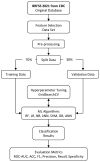Evaluating Binary Classifiers for Cardiovascular Disease Prediction: Enhancing Early Diagnostic Capabilities
- PMID: 39728286
- PMCID: PMC11678659
- DOI: 10.3390/jcdd11120396
Evaluating Binary Classifiers for Cardiovascular Disease Prediction: Enhancing Early Diagnostic Capabilities
Abstract
Cardiovascular disease (CVD) is a significant global health concern and the leading cause of death in many countries. Early detection and diagnosis of CVD can significantly reduce the risk of complications and mortality. Machine learning methods, particularly classification algorithms, have demonstrated their potential to accurately predict the risk of cardiovascular disease (CVD) by analyzing patient data. This study evaluates seven binary classification algorithms, including Random Forests, Logistic Regression, Naive Bayes, K-Nearest Neighbors (kNN), Support Vector Machines, Gradient Boosting, and Artificial Neural Networks, to understand their effectiveness in predicting CVD. Advanced preprocessing techniques, such as SMOTE-ENN for addressing class imbalance and hyperparameter optimization through Grid Search Cross-Validation, were applied to enhance the reliability and performance of these models. Standard evaluation metrics, including accuracy, precision, recall, F1-score, and Area Under the Receiver Operating Characteristic Curve (ROC-AUC), were used to assess predictive capabilities. The results show that kNN achieved the highest accuracy (99%) and AUC (0.99), surpassing traditional models like Logistic Regression and Gradient Boosting. The study examines the challenges encountered when working with datasets related to cardiovascular diseases, such as class imbalance and feature selection. It demonstrates how addressing these issues enhances the reliability and applicability of predictive models. These findings emphasize the potential of kNN as a reliable tool for early CVD prediction, offering significant improvements over previous studies. This research highlights the value of advanced machine learning techniques in healthcare, addressing key challenges and laying a foundation for future studies aimed at improving predictive models for CVD prevention.
Keywords: artificial intelligence; artificial intelligence in medical diagnosis; cardiovascular diseases; machine learning.
Conflict of interest statement
The authors declare no conflicts of interest.
Figures





References
-
- Cardiovascular Diseases. World Health Organization. [(accessed on 8 October 2024)]. Available online: https://www.who.int/health-topics/cardiovascular-diseases.
-
- Frąk W., Wojtasińska A., Lisińska W., Młynarska E., Franczyk B., Rysz J. Pathophysiology of Cardiovascular Diseases: New Insights into Molecular Mechanisms of Atherosclerosis, Arterial Hypertension, and Coronary Artery Disease. Biomedicines. 2022;10:1938. doi: 10.3390/biomedicines10081938. - DOI - PMC - PubMed
-
- Patidar S., Kumar D., Rukwal D. Comparative Analysis of Machine Learning Algorithms for Heart Disease Prediction. In: Singari R.M., Kankar P.K., editors. Advances in Transdisciplinary Engineering. IOS Press; Amsterdam, The Netherlands: 2022.
-
- Ananey-Obiri D., Sarku E. Predicting the Presence of Heart Diseases using Comparative Data Mining and Machine Learning Algorithms. Int. J. Comput. Appl. 2020;176:17–21. doi: 10.5120/ijca2020920034. - DOI
Publication types
LinkOut - more resources
Full Text Sources

